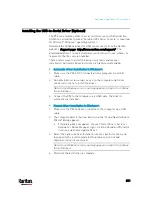
Appendix K: Additional PX3 Information
817
The IP address configured may take seconds to take effect.
Device-Specific Settings
A bulk configuration file will NOT contain any device-specific information
like the following list.
For further information, simply open the built-in bulk profile for a
detailed list of 'excluded' settings.
Device name
SNMP system name, contact and location
Part of network settings (IP address, gateway, netmask and so on)
Device logs
Names, states and values of environmental sensors and actuators
TLS certificate
Server monitoring entries
Asset strip names and rack unit names
Outlet names and states
TLS Certificate Chain
A TLS server sends out a certificate to any client attempting to connect to
it. The receiver determines whether a TLS server can be trusted by
verifying that server's certificate, using the certificate (chain) stored on
the receiver.
Therefore, to successfully connect to a TLS server, you must upload a
valid certificate or (partial) certificate chain to the receiver.
The uploaded certificate (chain) must contain all missing certificates
"related to" that TLS server's certificate in some way. Otherwise, the
connection made to that TLS server will fail.
For information on how the uploaded certificate (chain) is related to
a TLS server's certificate, see
What is a Certificate Chain
(on page
For an example of creating and uploading a TLS certificate to PX3,
see
Illustration - GMAIL SMTP Certificate Chain
(on page 821).
Summary of Contents for PX3-3000 series
Page 5: ......
Page 18: ...Contents xviii Index 841...
Page 93: ...Chapter 4 Connecting External Equipment Optional 69...
Page 787: ...Appendix J RADIUS Configuration Illustration 763 Note If your PX3 uses PAP then select PAP...
Page 792: ...Appendix J RADIUS Configuration Illustration 768 14 The new attribute is added Click OK...
Page 793: ...Appendix J RADIUS Configuration Illustration 769 15 Click Next to continue...
Page 823: ...Appendix K Additional PX3 Information 799...
















































